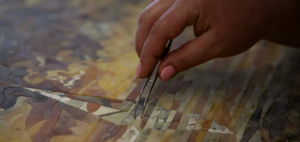Origin of amber
The Amazing Gift of Nature
The Amazing Gift of Nature
For millennia, the Baltic gemstone has been known as a precious treasure, a decorative stone, a remedy for ailments, and a fragrance. Throughout history, amber has always remained a luxury, available only to the chosen few, synonymous with wealth and power.
The “Sunstone” is not limited to the Baltic region alone: amber and fossil resins are found all over the planet. They vary in composition and age, and their locations are grouped into different provinces.

THE MAIN SOURCE OF AMBER
The primary area for a special type of amber called succinite is the Kaliningrad region. For centuries, over 90% of the world’s amber reserves have been concentrated in the Baltic Sea region. Numerous trade routes were established for the supply of Baltic gemstone.
The Value of Amber
The Value of Amber
The stone found on its shores has been used by craftsmen to create jewelry and magical amulets, consistently in demand due to its unique beauty and attributed magical powers. It is no wonder that the extraordinary properties of this material have given rise to numerous legends about the origin of the sunstone.
Subsequently, scientists debunked all myths and established that amber is fossilized resin from coniferous trees that grew millions of years ago. Any damage to the trees, such as cracks in the trunk, broken branches, or areas where the bark layer has been peeled off, is covered with resinous growths. These growths possess disinfectant properties and help in the healing of wounds, contributing to the restoration of the woody tissue.
Stone from the Amber Forest
When it comes to the origins of amber, it is known that forests once grew in the area of the present-day Scandinavian Peninsula and the Baltic Sea territory. Alongside pines, whose resin turned into amber, there were also deciduous plant species. The climatic conditions were favorable, with humidity and warmth, which prompted the pines to release that very resin.
Over time, rivers and streams washed out pieces of hardened resin from the ground and carried them into the sea (now the territory of the present-day Kaliningrad Peninsula). This is why the largest reserves of amber accumulated here.
Over 1 million years ago, a glacier shifted the layers of soil towards the foothills of the Carpathians, along with the Eocene deposits of amber. Amber is also found in areas formerly covered by glaciers.
Is the age of amber known?
The issues of the age and origin of amber remain a subject of debate, as amber is found in various ancient deposits. One of the factors complicating the estimation is the absence of remains of representative fossil organisms that could accurately determine its geological age. For now, it can be reliably stated that it is older than 33.9 million years (the upper boundary of the Priabonian stage and the Eocene epoch).
Diversity of the gemstone
The Baltic amber exhibits a wide variety in terms of shape and size. The color, shape, and texture of amber are influenced not only by the different tree species that produce the resin but also by the specific climatic conditions of each location. It can be transparent, translucent, or opaque. Primary resin formations without signs of subsequent mechanical impact are often found. Occasionally, very large specimens weighing 10-12 kg can be found.
Amber is classified into the following types:
– Succinite (the most popular variety today)
– Glessite (brownish hue)
– Bockerite (dark-colored)
– Gedanite (wax-yellow)
– Stantienite (black, brittle).
Special World
Special World
About 10% of all amber found are inclusions. This is a special type of preservation of fossil remains of organisms, when soft tissues remain, the volume of the fossil and its color. Their study is of great interest to paleontologists and helps to understand the biodiversity of the past and find additional data for research. At the same time, for the production of interior products, jewelry and other items, pure types of amber are especially valued today.
Year after year, people find new facts and create different products from the extracted amber treasures. Amber deposits are known all over the world. Each culture on the planet has its own attitude to this creation of nature and evaluates it in its own way.
















